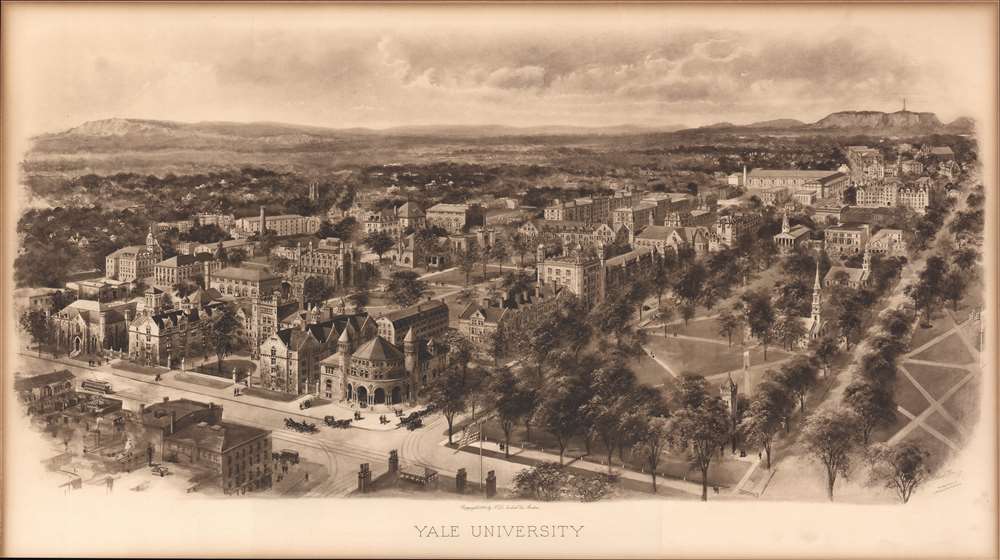This item has been sold, but you can get on the Waitlist to be notified if another example becomes available, or purchase a digital scan.
1906 Richard Rummell View of Yale Univeristy, New Haven, Connecticut
YaleUniversity-rummell-1906-2
Title
1906 (dated) 16 x 29 in (40.64 x 73.66 cm)
Description
A Closer Look
The view is centered on Osborne Hall (now demolished and replaced with Bingham Hall) with its distinctive chapel-like façade. Chapel Street runs in front of the hall and Temple Street can be seen running northward towards East Rock. Many of the extant buildings of the historic Old Campus, including Connecticut Hall (1752), are easily recognizable. Welch Hall and Lawrence Hall stand alongside College Street, across from the New Haven Green which is complete with the three chapels that still stand today: United Church on the Green (Congregational, 1814), Center Church (Congregational, 1812), and Trinity Episcopal Church on the Green (1816). In the distance the heights of East Rock, with its distinctive Soldiers and Sailors Monument, is clearly visible.Rummell University Views
Rummell was an American landscape artist known for his drawings of American universities. In 1906, Rummell issued his first university view - an illustration of Yale. That view was a sepia tone photogravure copyrighted by F. D. Nichols of and printed by A. W. Elson, both of Boston. A view of Harvard, likely Rummell's second view, also appeared in 1906 with the same Nicholson/Elson imprint. Subsequently, Littig and Company of New York commissioned Rummell to prepare watercolors of many of the nation's most prestigious colleges. From these watercolors, copperplates were engraved, and both photogravures and lithographs were issued. The photogravures were printed on extremely fine tissue which were then adhered to thicker boards. The borders were typically highly acidic, as here, so the photogravure images have a much lower survival rate than the lithographed images, which were printed on heavier lithograph paper.Most of Rummell's university views are strikingly similar in style, revealing the entire campus in panoramic splendor. The views are uniformly issued from an altitude of about 300 feet, suggesting that Rummell most likely worked from a balloon.
Rummell's First University View?
Of Rummell university views, the Yale and Harvard views are particular both in format and printing style. Unlike many Rummell university views, these early views appear in two formats, a sepia toned photogravure copyrighted by F. D. Nichols of Boston and the lithograph view issued by Littig in New York. It is likely that the photogravure is earlier, as it often lacks a title. These and other oddities suggest that the Yale view was the first university views Rummell published, and Harvard the second. Being a Brooklynite, Yale would have been one of the nearest and easiest universities to focus on as a prototype for the series. Of all Rummell's university views, it is further noteworthy that the Nichols / Elson / Rummell Yale view is one of the rarest to the market.In more recent times, many of the original lithographic plates for Rummell's college views have been rediscovered, leading to multiple modern reprints of the Littig editions, but the original lithograph printings and especially the photogravures, as here, have become extremely rare.
CartographerS
Richard W. Rummell (1848 – June 4, 1924) was an American artist active in Brooklyn during the late 19th and early 20th century. Rummell was born in Canada, the son of German immigrant Frank X. Rummell and his wife Eliza Rummell. He immigrated to the United States as a youth settling with his parents in Buffalo. He relocated to Brooklyn when he was in his mid-30s, setting up an illustration office at 258 Broadway in Manhattan. Rummell is best known for his series of views of American colleges completed around the turn of the century. Since Rummell's views universally appear to be drawn from an altitude of about 300 feet, it has been speculated by many art historians that he worked from a balloon. Rummell was also a bit of a futurist and among his more interesting works are a series of speculative images of the New York of tomorrow, with vast airships, trains running over the tops of skyscrapers, and elegant sky bridges. In the 1950s, the original printer's plates for many of Rummell's university views were rediscovered in a Brooklyn warehouse. Rummell's Brooklyn home was located at 45 Bay 28th Street and later 73 Hanson Place. In addition to his work as a visual artist, he was an accomplished actor and an avid yachtsman. He founding member of the Bensonhurst Yacht Club, where his yacht, the Careless was usually docked. He was also a member of the Royal Arcanum fraternal order. Rummell was survived by his wife, Emmeline Rummell, daughter, Chrissie Atkinson, and two sons, John Tribel Rummell, and Richard Rummell Jr., who became a famous Florida architect. More by this mapmaker...
Alfred Walter Elson (March 20, 1859 - November 22, 1938) was an American photographer, printer, and lithographer based in Boston. Elson was born in Massachusetts, the son of German-Bavarian immigrants. Elson's father, Julius, was a jeweler. Elson operated under the imprint of A.W. Elson and Company, active from roughly 1894 to 1925. Elson is best known for his fine photogravure plates, among them many of Richard Rummell's iconic college views. Elson prints are often mis-identified as 'Welson' due to the often-weak impression of his imprint. The Elson offices were located at 146 Oliver Street, Boston. Elson died of a lingering sickness in 1938. He was survived by his wife Maud, who lived until 1955. Learn More...
Francis Durando Nichols (October 2, 1867 - February 28, 1912) was an American printer and publisher active in the early 20th century. In 1905, he founded F. D. Nichols and Company, a New York and Boston based printing house specializing in deluxe publications, catalogs, and diplomas. Prior to this time, he worked in illustration and advertising for Ginn and Company. Learn More...

